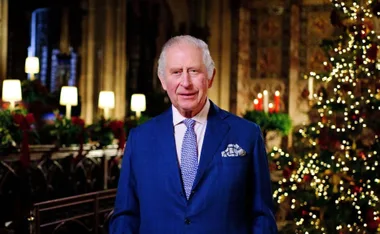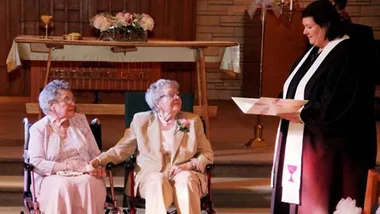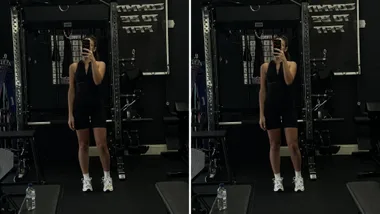Hundreds of people turned out to farewell Queen Elizabeth and Prince Philip today as they boarded their plane to return to the UK.
It was the royal couple’s 16th visit to Australia, and they kept extremely busy, visiting Canberra, Brisbane, Melbourne and Perth during their 10 day stay.
The queen and duke have been extremely well-received across Australia, attracting tens of thousands of people everywhere they went.
They will now return home to prepare for the queen’s diamond jubilee celebrations next year.

Queen Elizabeth as she prepares to leave Australia.

The queen greets crowds at the Great Aussie BBQ.

Queen Elizabeth arrives at the queen’s banquet.

Queen Elizabeth looked dazzling in a diamond and sapphire crown.

The queen’s speech – Elizabeth talking at the banquet.

Her Majesty addresses the Queen’s Banquet.

The queen and Prince Philip at the banquet.

Queen Elizabeth.
{“collection”:[{“code”:”1add5c93-65d0-4d15-ba87-a23b0172cd69″,”heading”:null,”sortOrder”:0,”text”:”Tie the bay leaves and thyme together with string.\u000d\u000aSaute onion and garlic until soft and translucent, then add the carrot, tomatoes and stock. “},{“code”:”3399a5dc-a977-47c6-ad7f-a23b0172cd69″,”heading”:null,”sortOrder”:0,”text”:”Add the herbs and lemon rind and simmer covered for ½ hour.”},{“code”:”1e701568-90c6-4f53-b8a0-a23b0172cd69″,”heading”:null,”sortOrder”:0,”text”:”Cube the fish, add to braising liquid with the mussels and continue to simmer for a further 1\/2 hour. “},{“code”:”7a1d98d7-3b2d-4cf3-8625-a23b0172cd69″,”heading”:null,”sortOrder”:0,”text”:”Once fish has cooked and mussels have opened, scatter with chopped parsley and serve with a bitter green salad and crusty fresh bread.”}]}

Queen Elizabeth at the queen’s banquet.

Queen Elizabeth officially opens CHOGM in Perth.

The queen gives her speech praising Australia and the Commonwealth.

The official CHOGM delegates photo.

The queen and Prince Philip arrive at CHOGM.

Queen Elizabeth attends a garden party at Perth’s Government House.

Her Majesty at her Perth state reception.

Queen Elizabeth seemed delighted to be at Clontarf Aboriginal College.

The monarch looked stunning in a green and white printed coat with matching hat.

The queen with an AFL ball at the college.

The queen watches a traditional Aboriginal performance.
{“collection”:[{“code”:”a1bf6cc9-9239-47ee-b305-a23b0173d033″,”heading”:null,”sortOrder”:0,”text”:”Choux Pastry\u000d\u000aPlace water and butter in saucepan and bring to the boil. Add flour all at once; stir quickly until mixture forms a ball. Remove from heat and cool slightly.\u000d\u000aPlace mixture in a large mixing bowl. Add eggs gradually while mixing, incorporating each egg well before adding more. An electric mixer makes this job much easier.\u000d\u000aCheck the consistency of the batter after adding the fifth egg; a peak should just fall back on itself.\u000d\u000aPipe or spoon walnut-size balls of the mixture onto baking trays, allowing room for spreading. Sprinkle with a little water to aid rising.\u000d\u000aBake the choux pastries in a preheated 220°C oven for about 15 minutes or until they are well puffed and set. \u000d\u000aReduce the temperature to 160°C and cook a further 15 – 20 minutes until they are completely dry.\u000d\u000aMake a hole in each profiterole with the point of a knife and return to the oven until very dry. \u000d\u000aCustard: Place the milk and sugar in a heavy based saucepan and bring to the boil. \u000d\u000aWhisk together the egg yolks, eggs and flour and pour over the hot milk in regular intervals, stirring constantly. \u000d\u000aReturn to the saucepan and cook over medium heat until custard boils and thickens. \u000d\u000aRemove from the heat and scrape down the sides of the saucepan. Cool at room temperature. Beat before using and pipe into cooked choux pastries.\u000d\u000a**Caramel: Combine the sugar, water and glucose in a heavy-based saucepan. Stir constantly over high heat until the sugar has dissolved. \u000d\u000aSimmer for 2 to 3 minutes, covered with a lid: this will help steam of any grains of sugar from the sides of the saucepan. \u000d\u000aBrush down the sides of the saucepan with a moistened pastry brush; it is vital that not even one grain of sugar remains.\u000d\u000aSimmer over medium heat until the mixture begins to turn to straw colour. Remove from the heat and stand the pot in cold water to stop the cooking process.”}]}**

The queen with performers.

The queen accepts a gift of the college’s famous kangaroo stew.

Queen Elizabeth aboard her royal tram in Melbourne.

The queen seemed to enjoy her tram trip.

The queen greets fans in Melbourne’s Federation Square.

The queen in Melbourne’s new Royal Children’s Hospital.

The queen greets fans in Federation Square.

The queen at the meerkat enclosure in the new children’s hospital.

The queen arriving at the Australian War Memorial.

The royals took time to greet crowds despite the pouring rain.

The queen is escorted into the Australian War Memorial.

The queen laying a wreath of poppies in the Tomb of the Unknown Soldier.

The queen and Prince Philip at the Australian War Memorial.

The queen talks to Australian war veterans about their time in combat.

The queen looked pensive as she cruised down the Brisbane River.

The queen was thrilled with this boy, who dressed like one of her famous guards.

The queen greeting fans in Brisbane.

The queen, Prince Philip and Anna Bligh meet a koala.

The queen and the Duke of Edinburgh in Brisbane.

The queen chats to Queensland Premier Anna Bligh.

The queen makes a speech in Brisbane’s South Bank region.

Queen Elizabeth at St John’s Anglican Church in Canberra.

The queen laughed as she chatted to horse trainer Bart Cummings.

Queen Elizabeth greets well-wishers outside the church.

Prince Philip at the Commonwealth Study Conferences alumni meeting.

Prince Philip looks at Quentin Bryce during his speech.

The queen greets a war hero she first met at Buckingham Palace 58 years ago.

Queen Elizabeth at the Trooping of the Colour.

The queen inspects cadets at the Royal Military College Duntroon.

The queen blesses the college’s new colours.

Queen Elizabeth the the Trooping of the Colour.

The queen inspects cadets in formation.

The queen and Julia Gillard arrive at the official reception at Parliament House.

The queen, Prince Philip and Julia Gillard stand for the national anthem.

The queen giving her rousing speech.

The queen with Julia Gillard.

The monarch and the prime minister.

Queen Elizabeth was visibly delighted to meet this 7ft basketballer at the reception.

Queen Elizabeth with Julia Gillard at Government House.

The queen with Tony Abbott.

The queen and Prince Philip toured the grounds of Government House in a golf buggy.

Kangaroos watch the royal couple pass by.

The queen looked wonderful as she arrived at Floriade.

The queen and the Duke of Edinburgh arrive on the royal barge.

The queen steels herself for the day ahead.
http://cdn.assets.cougar.bauer-media.net.au/s3/digital-cougar-assets/AWW/2013/09/16/30921/132196032.jpg

The queen accepts flowers from wellwishers.

Children present the queen with flowers and gifts.

Children greet Queen Elizabeth.

Elizabeth strolls through Floriade.

The queen talks to Floriade’s head gardener.

Queen Elizabeth with Governor-General Quentin Bryce.

Queen Elizabeth and Prince Philip disembark their plane in Canberra.

The queen waves at wellwishers.

The queen greets Prime Minister Julia Gillard and Governor-General Quentin Bryce.

The monarch crosses the tarmac.

Elizabeth chats to school children.

The queen greets wellwishers.

The queen couldn’t stop smiling.

Her Majesty also received lots of flowers.

Queen Elizabeth and Prince Philip during their first visit to Australia in 1954.

Queen Elizabeth clutching flowers from wellwishers in Brisbane in 1982.

The queen attends an Aboriginal smoking ceremony near Cairns in 2002.

Queen Elizabeth greets fans in Sydney in 2006.

The queen’s Australian visit was big news again in 1977.

Another Queen’s visit special edited in 1982.

Elizabeth’s 1981 visit also excited the Australian public.

The queen’s visit made the cover of the *Australian Women’s Weekly* in 1963.
The queen’s visit made the cover of the Australian Women’s Weekly in 1963.






.jpg?resize=380%2C285)
.png?resize=380%2C285)


































